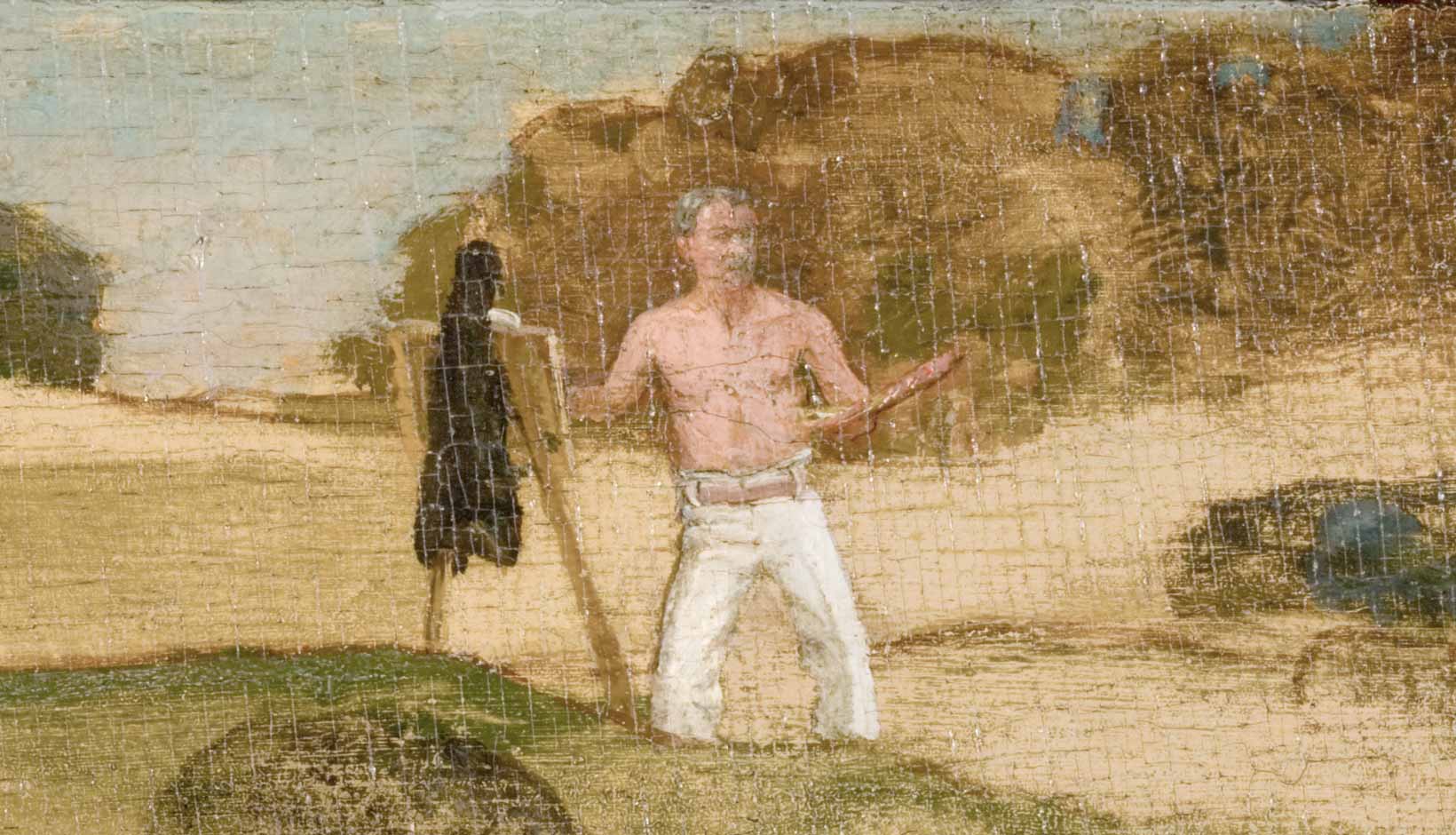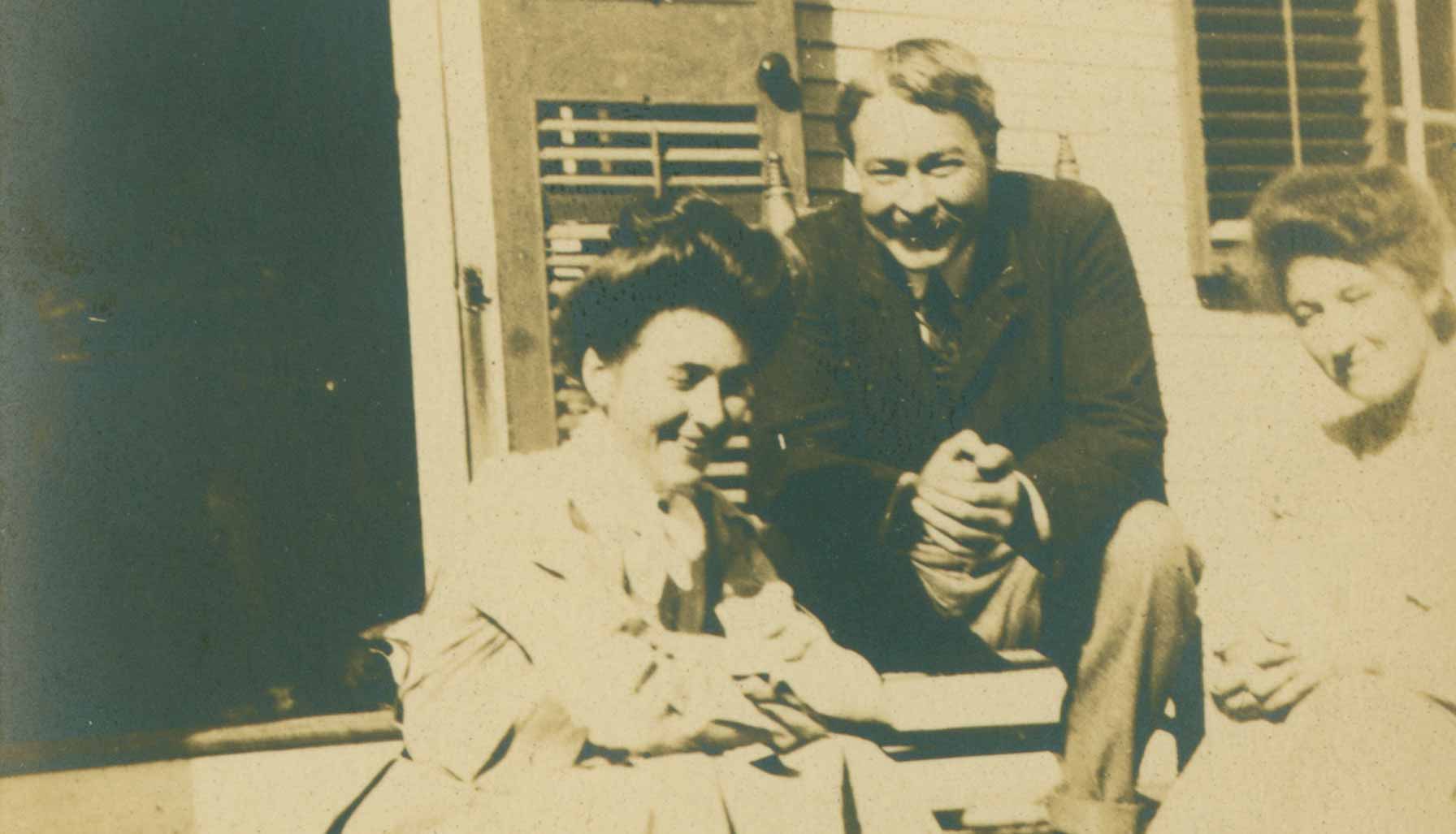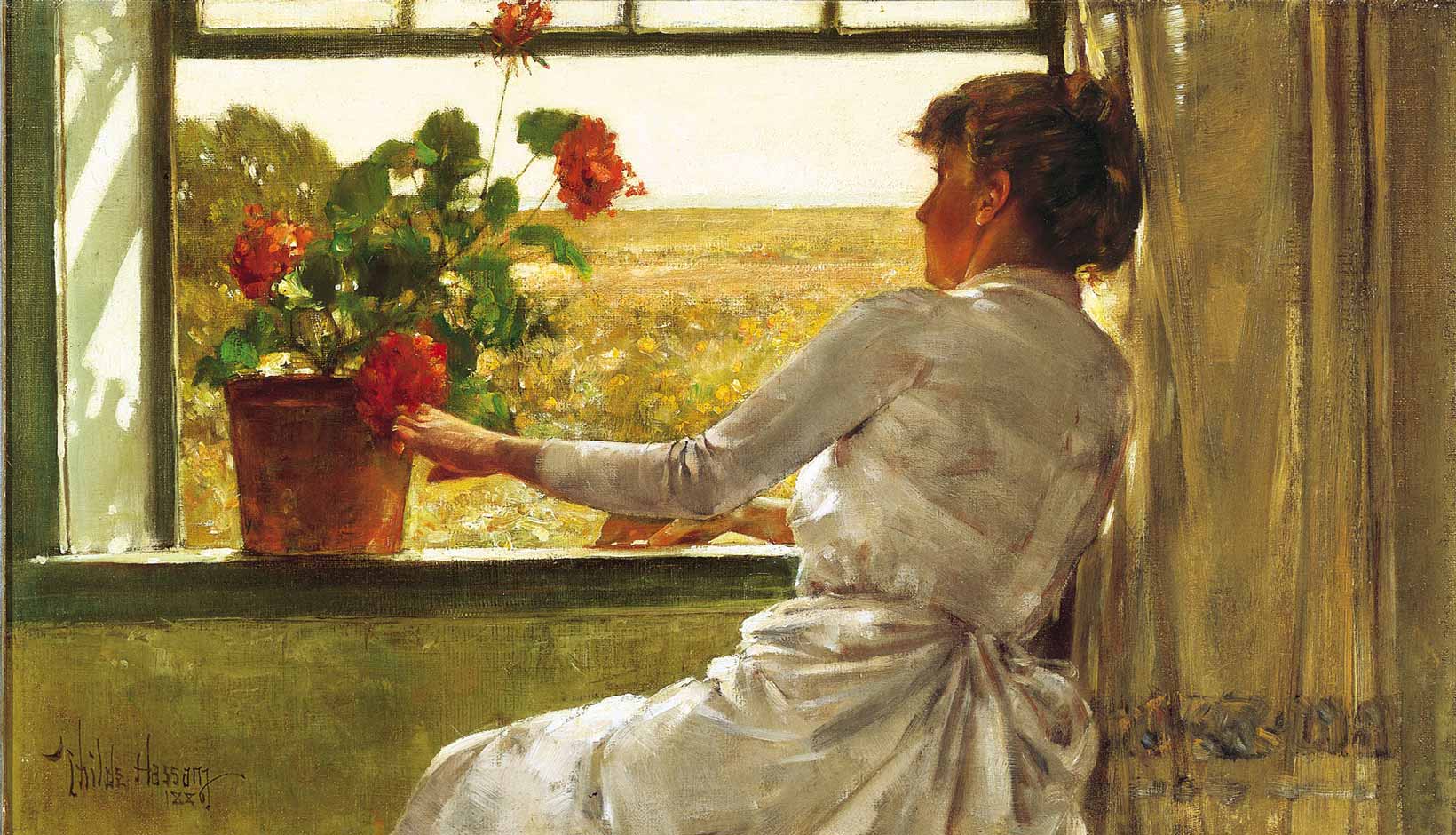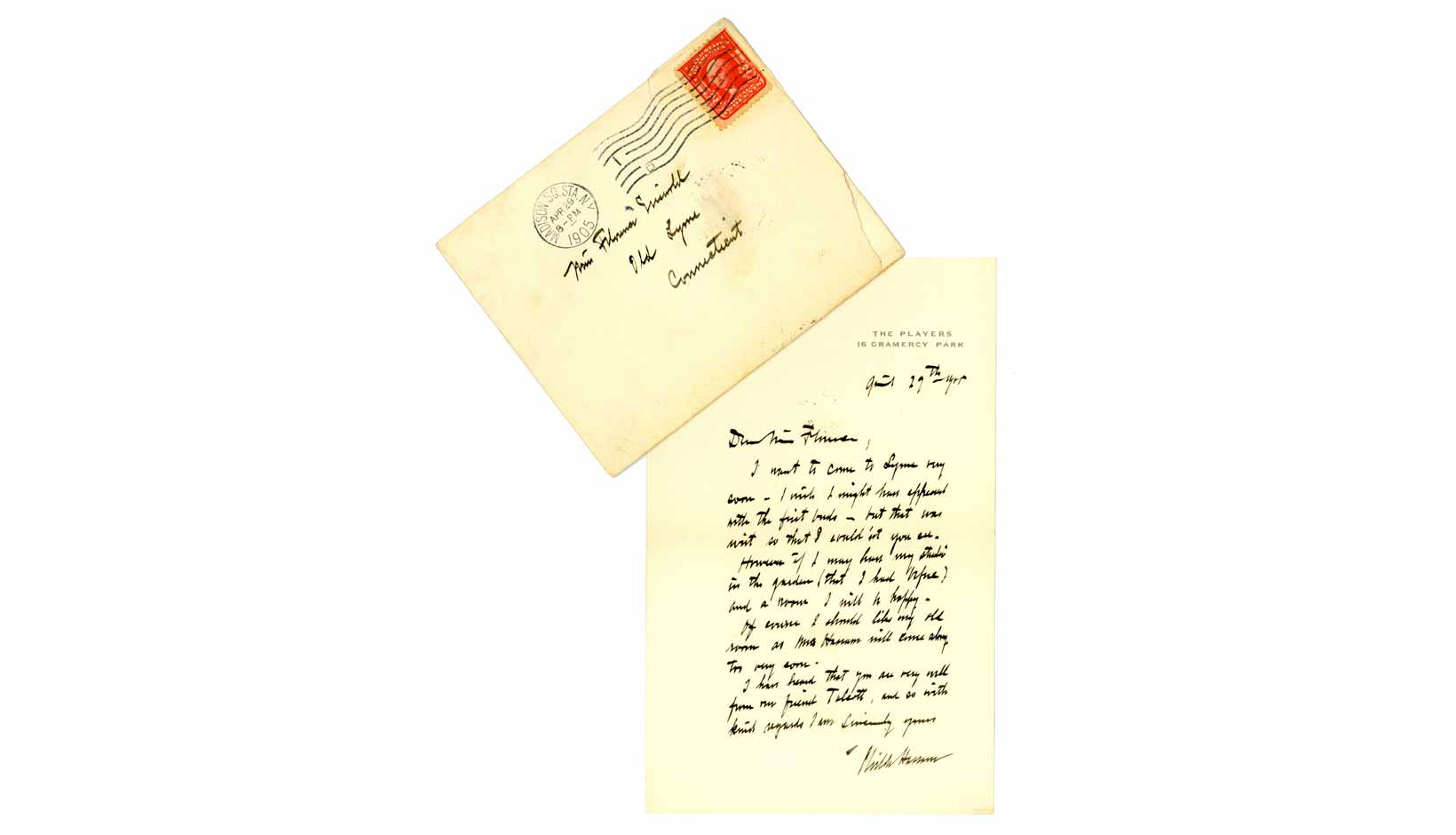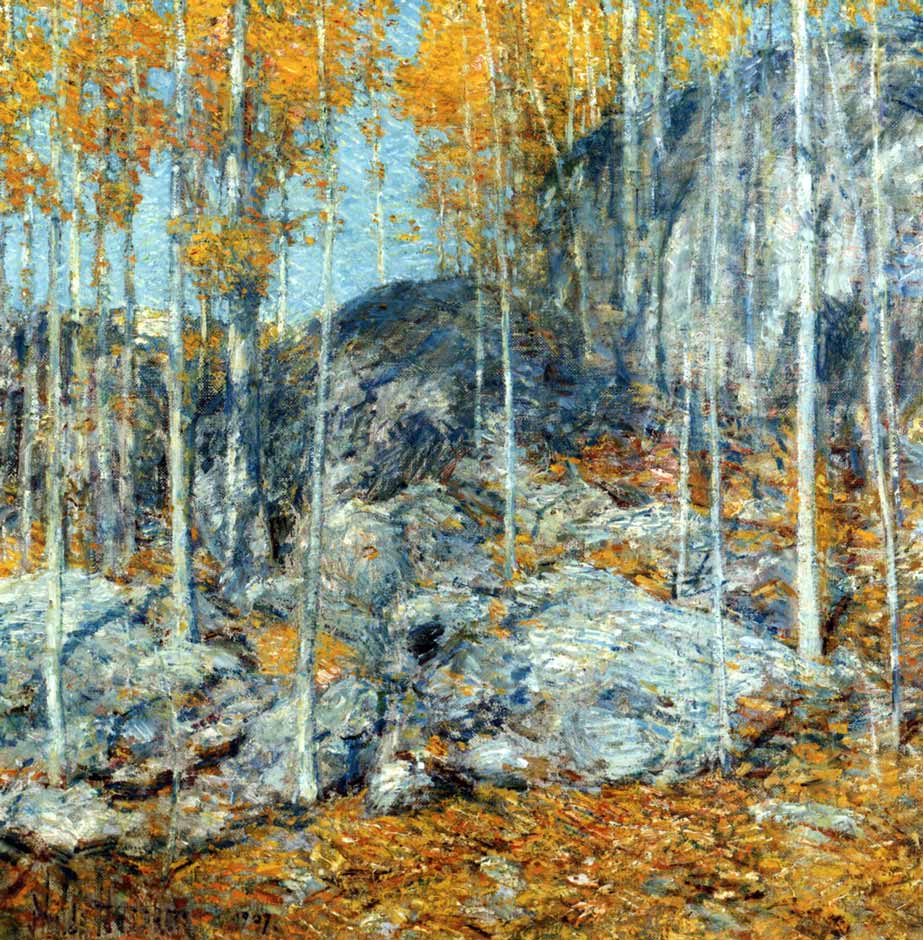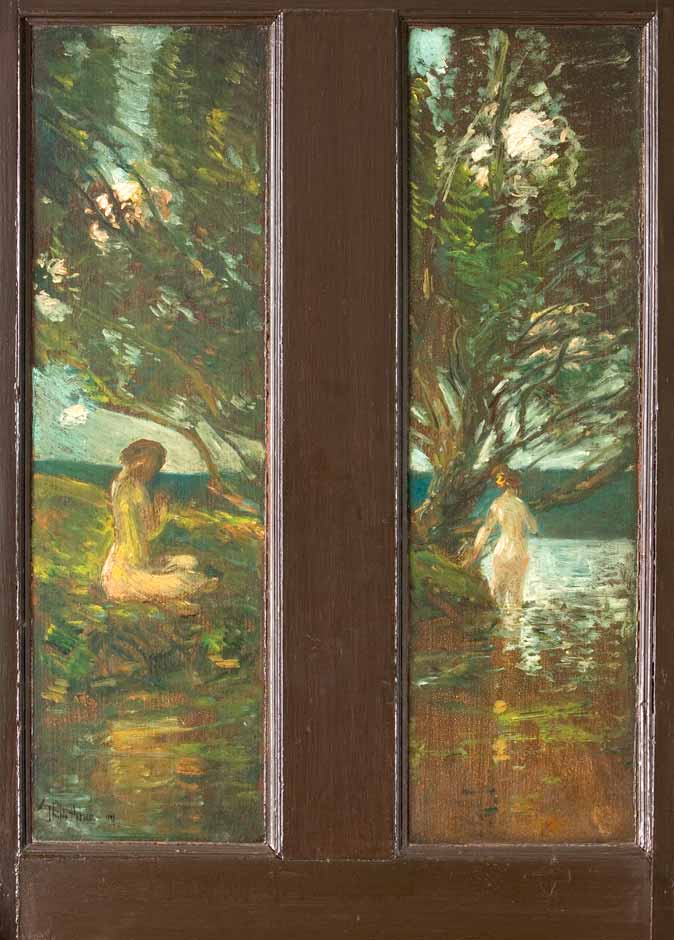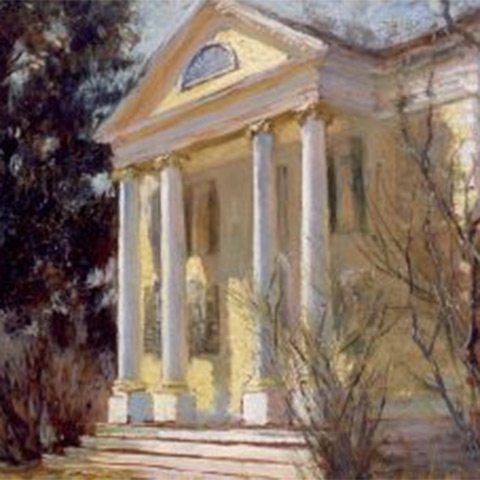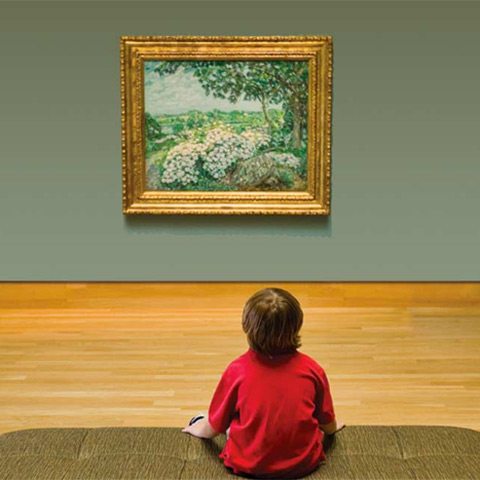Fox Chase
Childe Hassam
- Museum Hours: Tuesday through Sunday, 10am to 5pm
Childe Hassam is shown standing at his easel in The Fox Chase, painting en plein airwith his shirt off, while the fox and pack of dogs rushes past.
Hassam is probably the most famous artist affiliated with the Lyme Art Colony.
Frederick Childe Hassam
Born October 17, 1859, Dorchester, Massachusetts
Died August 27, 1935, Easthampton, New York
In Old Lyme, summers, 1903-c. 1907
Hassam is credited with bringing the style of Impressionism to Old Lyme. Before Hassam, the Old Lyme artists painted in style known as Tonalism.
Hassam would sign his name preceeded with a crescent moon shape that became his trademark. Although he was born in Massachusetts, he would often let people think he was Arab because of the exotic spelling of his last name.
Hassam painted several versions of the church at Old Lyme making it one of the most famous churches in New England.
His presence shifted the stylistic focus of the earlier colony away from the Tonalism of Henry Ward Ranger. Like Ranger, Hassam was immediately smitten with the Connecticut village. Hassam wrote to fellow painter J. Alden Weir about Old Lyme, “We are up here in another old corner of Connecticut . . . And it really is a pretty fine old town.” Hassam takes on the unofficial role of leader of the colony as Ranger moves his base of operation to Noank, Connecticut, and he encourages younger artists to come to the colony to paint.
Called “Muley” by his friends (supposedly because of his strong opinions and his stubbornness in changing them), Hassam also enjoyed people thinking his name was Arabian, although he was born north of Boston to American parents. He dropped this first name of Frederick and began to sign his name preceded by a crescent moon, a symbol of his adopted Arab lineage. He began his art career as a wood engraver and was soon creating illustrations for popular magazines such as Harper’s and Scribner’s.
He studied art in Lowell and Boston before heading off to paint throughout Europe from Scotland to Spain. By 1886, he’s in Paris studying at the Académie Julian. It was in Europe that he met many of the friends he would chum around with in Connecticut art colonies in Cos Cob and Old Lyme.

Called “Muley” by his friends (supposedly because of his strong opinions and his stubbornness in changing them), Hassam also enjoyed people thinking his name was Arabian, although he was born north of Boston to American parents. He dropped this first name of Frederick and began to sign his name preceded by a crescent moon, a symbol of his adopted Arab lineage. He began his art career as a wood engraver and was soon creating illustrations for popular magazines such as Harper’s and Scribner’s. He studied art in Lowell and Boston before heading off to paint throughout Europe from Scotland to Spain. By 1886, he’s in Paris studying at the Académie Julian. It was in Europe that he met many of the friends he would chum around with in Connecticut art colonies in Cos Cob and Old Lyme.
When he arrived in Old Lyme in 1903, he was painting in a robust Impressionistic style, using bright, high-key colors and thick, short, staccato brushstrokes that seemed to flicker on the canvas. Years earlier he painted in more of a Tonalist style. The painting “Across the Common on a Snowy Evening” (1885-1886) is a perfect example of this earlier style. His painting style changed while he is in Europe, clearly converted by the work of Claude Monet and other French artists (he actually sublet a studio used by Auguste Renoir while in Paris). He took on all the stylistic characteristics of the French painters, but turned his attentions to subjects that are more American. Rather than painting modern nightlife in the Parisian cafes as they often did, Hassam painted New York (draped in American flags), as well as the flower-filled gardens and white churches that became synonymous with old New England.
In fact, Hassam painted the First Congregational Church of Old Lyme at least three times before it mysteriously burned to the ground in 1907. In a letter to Miss Florence he rants about the loss of one of his favorite subjects. “Who is the divil [sic] who did it? I was very disgusted with humanity when I heard of it, and I don’t need to say that I always had a real and pagan delight I the many and beautiful aspects of the old church.” Indeed, it was paintings like Hassam’s that helped the church fathers build a replica of the lost church that opened in 1910.
Hassam seemed to thrive during his time in Old Lyme. He painted in one of the best studios on the property, located between the river and the gardens with excellent views of both. He nicknamed it “Bonero Terrace” and outfitted it with a large Victorian sofa. He is remembered for his colorful behavior, arriving at all hours, drinking with abandon, throwing an orange through the dining room window, and rummaging through old trunks in the attic for a flowered dressing gown to wear down into the village as a lark.

A letter from Childe Hassam to Florence Griswold, 1905
Excerpt from letter:“I want to come to Lyme very soon. I wish I might have appeared with the first buds—but that was writ so I couldn’t you see. However if I may have my studio in the garden (that I had before) and a room I will be happy. Of course I should like my old room as Mrs. Hassam will come along too very soon.”
Hassam had a great friendship with Florence Griswold and would write letters to her before and after his many visits. For Miss Florence’s dining room he painted a panel with a floral scene, a door with nude bathers in the Lieutenant River, and he collaborated with Walter Griffin and Henry Rankin Poore on a landscape with a reclining cow. While in Old Lyme he paints the river (sometimes with bathers and mountain laurel), the rocky uplands, as well as the church. His vibrant paintings would influence the next generation of Lyme painters, even after 1909, when he no longer stopped at the boardinghouse in Old Lyme.
Hassam is perhaps best known as the founder of The Ten, a group of American painters, many of whom had studied in Paris, who banded together in 1897 to show their work after deciding that the Society of American Painters was too conservative. Upon his death in 1935, Hassam bequeathed the complete contents of his studio (nearly 450 paintings, pastels, and decorative panels) to the American Academy of Arts and Letters in New York. According to Hassam’s wishes, the collection was sold at auction and the proceeds used to purchase contemporary art for American museums.

